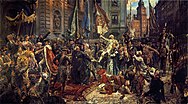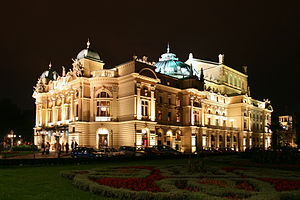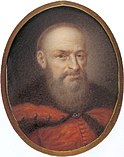Welcome to the Poland Portal — Witaj w Portalu o Polsce

From Polish history –
Selected image –
Did you know –
- ... that Zofia Posmysz (pictured), Auschwitz inmate No. 7566, wrote an audio play based on her memories, which formed the basis for her 1962 novel Passenger, a 1963 film, and a 1968 opera?
- ... that the announcement of the reopening of the Embassy of Poland in Manila coincided with Poland's decision to expand its economic involvement in Asia?
- ... that Polish mountain climber Tomasz Mackiewicz went missing on January 27 during his seventh attempt to reach the summit of the 8,126-metre (26,660 ft) high Nanga Parbat in Pakistan?
- ... that Monica Gardner's life was shaped by finding out that Bonnie Prince Charlie's mother was Polish?
- ... that, during The Holocaust in German-occupied Poland, Cypora Zonszajn could not live without her closest family and returned to the Siedlce Ghetto to perish along with them?
You can help!
Selected biography –
Selected location –
Poland now
Recent events
-
Poland at the 2024 European Athletics Championships:






- On 10 June, Natalia Kaczmarek (pictured) won a gold medal in 400-meter dash.
- On 9 June, Wojciech Nowicki won a gold medal in hammer throw.
- On 9 June, the ruling Civic Coalition won the European Parliament election in Poland.
- On 8 June, Polish tennis player Iga Świątek won the 2024 French Open, her fifth Grand Slam singles title.
- On 21 May, Jan A.P. Kaczmarek, a composer best known for writing film scores, died at the age of 71.
- On 10 May, an unusually spectacular aurora borealis was observed in large parts of Poland due to an intense solar storm.
Ongoing
Constitutional crisis •
Belarus–EU border crisis •
Ukrainian refugee crisis •
Polish farmers' protests
Holidays and observances in July 2024
(statutory public holidays in bold)
- Battle of Grunwald anniversary (reenactors pictured), 15 July
Subcategories
Topics
Related portals
|
|
|
|
|
|
|
|
| Belarus | Czech Republic | Germany | Lithuania | Russia | Slovakia | Ukraine |
|
|
|
|
|
| Europe | Catholicism | Communism | European Union |
Associated Wikimedia
The following Wikimedia Foundation sister projects provide more on this subject:
-
Commons
Free media repository -
Wikibooks
Free textbooks and manuals -
Wikidata
Free knowledge base -
Wikinews
Free-content news -
Wikiquote
Collection of quotations -
Wikisource
Free-content library -
Wikiversity
Free learning tools -
Wikivoyage
Free travel guide -
Wiktionary
Dictionary and thesaurus
Wikipedias in the languages of Poland
|
|
Kaszëbskô Wikipedijô Kashubian Wikipedia |
|
Polska Wikipedia Polish Wikipedia |
|
Ślůnsko Wikipedyjo Silesian Wikipedia |
|
Wymysiöeryś Wikipedyj Vilamovian Wikipedia Incubator |
Беларуская • Česky • Deutsch • Հայերեն • Lietuvių • Romani • Русский • Slovenčina • Українська • ייִדיש






























